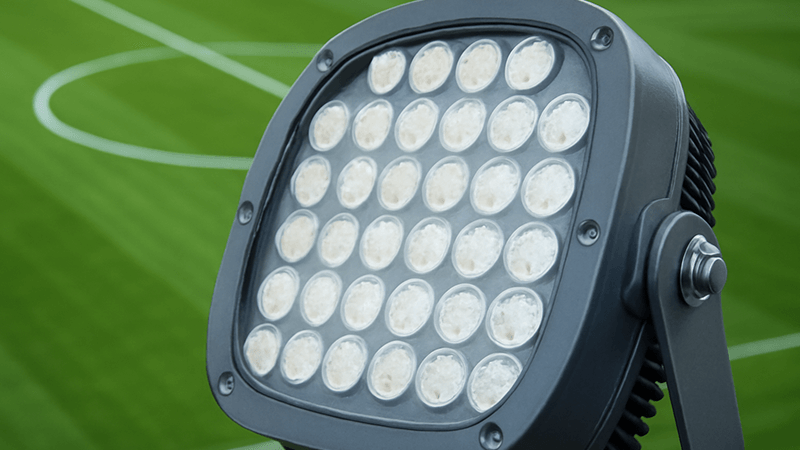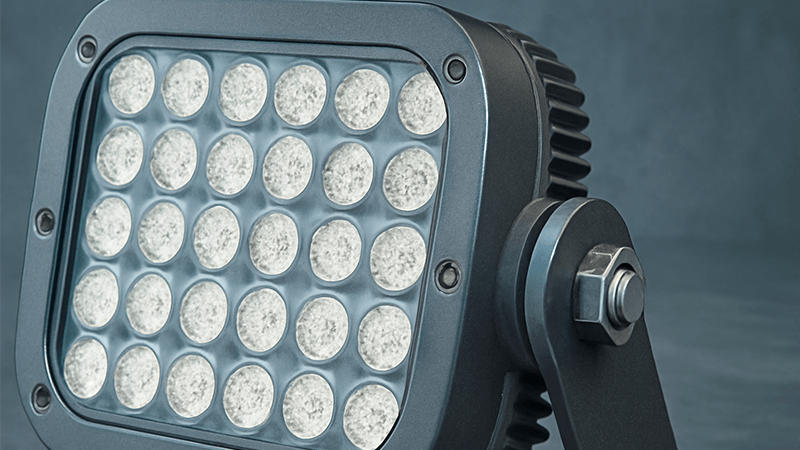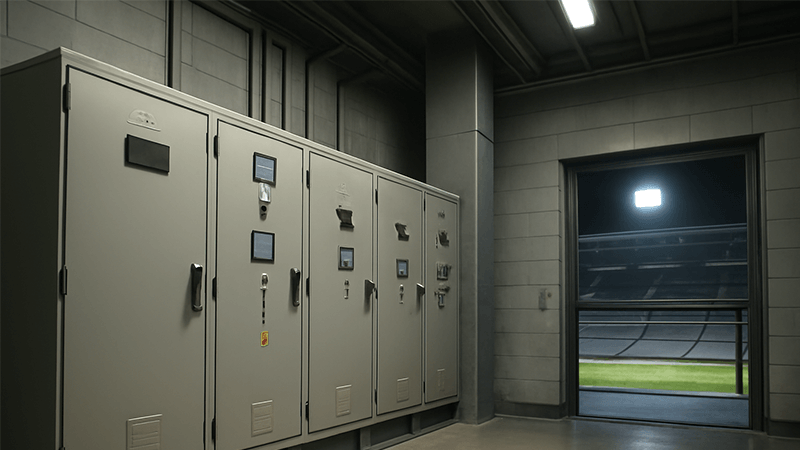Old stadium lights are costly and inefficient, often flickering and failing at critical moments. Modern stadiums have embraced a far superior lighting solution that enhances the experience for everyone.
Yes, virtually all modern stadiums use LED lights. They are the standard because they meet strict broadcasting requirements for brightness and clarity, offer massive energy savings, and provide advanced control for spectacular light shows.

The switch to LED wasn’t just about changing a few bulbs; it was a complete technological leap. This change has redefined what’s possible for lighting up massive venues, impacting everything from player safety to fan entertainment. It’s a comprehensive solution that involves optics, engineering, and smart controls. Let’s look deeper into what makes these lights the undisputed champions in the world of sports.
What kind of lights are used in stadiums?
Choosing the right light for a massive stadium is a huge challenge. The wrong choice leads to poor visibility for players and fans, bad broadcast quality, and crippling energy bills.
Modern stadiums exclusively use high-power LED floodlights. Previously, metal halide lamps were the go-to choice, but LEDs have replaced them completely due to their superior light quality, instant-on capability, energy efficiency, and advanced controls for dynamic effects.

The Journey from Metal Halide to LED
I’ve been in the lighting industry long enough to see this entire transition firsthand. For decades, metal halide (MH) lamps were the best we had. They could produce a lot of light, but they came with serious drawbacks. I remember working on an installation where a brief power outage meant we had to wait nearly 20 minutes for the MH lamps to cool down and then warm back up to full brightness. For a live event, that kind of delay is a disaster. MH lamps also consumed enormous amounts of power and their color quality would degrade over time, shifting towards a green or pink tint that looked terrible on camera. Maintenance was a constant, costly headache, involving expensive bulb replacements and difficult work on high masts.
Why LED is the Undisputed Champion
LED technology solved all of these problems. The move to LED wasn’t just an upgrade; it was a revolution. The most immediate benefit is the instant on/off capability. There’s no warm-up time, which gives event operators total control. The energy savings are also massive, often cutting electricity consumption by 60-75% compared to a similar MH system. This translates into huge operational savings for the stadium. The lifespan of an LED fixture, often exceeding 100,000 hours, drastically reduces the need for maintenance. Replacing a light on a 50-meter-high mast is a dangerous and expensive job, so doing it once a decade instead of every couple of years is a game-changer.
| Feature |
Metal Halide (MH) |
High-Power LED |
| Energy Efficiency |
Low |
Very High (Saves 60-75%) |
| Lifespan |
6,000 – 20,000 hours |
80,000 – 100,000+ hours |
| Warm-up Time |
15-20 minutes |
Instant |
| Color Rendering (CRI) |
65-70 (Fair) |
85-95+ (Excellent) |
| Control |
Limited On/Off |
Dimmable, DMX for Light Shows |
| Maintenance |
Frequent bulb replacement |
Minimal |
The Importance of Specialized Optics
A crucial point that many people miss is that a stadium light is more than just a powerful LED chip. The real magic is in the optics. Each LED light is fitted with a precision lens that directs the light exactly where it needs to go. In my work at Upward Lighting, we engineer custom optical systems for every project. We use different beam angles—some narrow to project light over a long distance, and some wide to illuminate areas close to the masts. This precise control ensures perfect uniformity on the field, eliminates glare for players and spectators, and prevents light from spilling into the surrounding neighborhoods. This optical engineering is what separates a professional system from just a bright light.
Imagine watching a championship football match where the broadcast flickers or the ball is lost in shadows. Poor lighting can ruin the game, frustrating fans and broadcasters alike.
Yes, all professional and newly built football stadiums use LED lights. The high-definition and slow-motion replays common in modern football broadcasting require the flicker-free, high-quality light that only LEDs can provide, ensuring a perfect picture for millions of viewers at home.

Meeting the Demands of Modern Broadcasting
Football is a global spectacle, and the standards set by organizations like FIFA and UEFA are incredibly strict. Modern broadcasting uses ultra-high-definition (4K/8K) cameras and super-slow-motion replays, which are extremely sensitive to light quality. This is where LEDs truly shine. One of the most important factors is the Television Lighting Consistency Index (TLCI), a measure created specifically for broadcast quality. While CRI measures how colors appear to the human eye, TLCI measures how colors appear to a camera. Professional LEDs for stadiums must have a very high TLCI rating, typically above 90, to ensure that team jerseys and field markings look vibrant and accurate on screen. Furthermore, LEDs are "flicker-free" at high frame rates. Old metal halide lights had an inherent flicker that was invisible to the eye but would cause horrible banding and strobing effects in slow-motion replays. With LED, every replay is crystal clear.
A Case Study in Upgrading
A few years ago, I worked with a client who managed a mid-sized football stadium. They were losing out on bids to host regional tournaments because their old metal halide lighting system didn’t meet modern broadcast standards. The upfront cost of an LED retrofit seemed high, but we broke down the numbers. We showed them that the 70% reduction in energy consumption would pay for the entire system in under four years. The near-zero maintenance costs would save them tens of thousands more each year. But the real selling point was the new revenue they could generate. After we installed a new, fully DMX-controlled LED system, they were able to host televised night games and even concerts. The ability to create dynamic pre-game light shows became a huge draw for fans, increasing ticket sales. The investment didn’t just save them money; it created a new, modern venue and a new source of income.
More Than Just Light: The Entertainment Factor
The control capabilities of LED systems have also transformed the fan experience. With DMX controls—the same technology used in stage and concert lighting—stadium operators can create stunning effects. They can flash the lights in team colors after a goal, create sweeping patterns during halftime, or instantly bring the stadium to full brightness for kickoff. This turns a simple football match into a full-blown entertainment event, creating an unforgettable atmosphere that keeps fans coming back. This is a level of engagement that was simply impossible with the old on-or-off metal halide systems.
What are stadium lights made of?
You look up at a stadium light mast and see a complex piece of equipment. You worry about its durability against harsh weather and its ability to perform reliably for years.
Stadium lights are made of rugged, high-grade materials designed for longevity and performance. The main housing is typically die-cast aluminum for heat dissipation, the lens is polycarbonate for impact resistance, and the internal components are all industrial-grade to withstand extreme conditions.

The Anatomy of a High-Power LED Fixture
A professional stadium light is a marvel of materials engineering, designed to last for decades in some of the most exposed environments imaginable. Let’s break down the key components that we focus on when manufacturing these fixtures at Upward Lighting.
1. Housing and Heat Sink:
The outer body, or housing, is almost always made from die-cast aluminum. We use specific alloys like ADC12 aluminum because it offers a great balance of strength, low weight, and excellent thermal conductivity. The housing isn’t just a shell; it’s also the heat sink. High-power LEDs generate a lot of heat, and this heat must be pulled away from the LED chips to ensure a long life and stable performance. We design intricate fins and channels into the housing to maximize the surface area, allowing air to flow freely and cool the fixture passively. Proper thermal management is probably the single most important factor in the longevity of an LED light.
2. Optics and Lens:
The clear cover over the LEDs is not just glass. We use high-impact, UV-stabilized polycarbonate (PC). This material is virtually unbreakable and won’t turn yellow or become brittle from sun exposure. The individual lenses that shape the light beam are also made from specialized optical-grade PC or PMMA. These lenses are precisely molded to create the exact beam angle required, from a narrow 15-degree spot to a wide 120-degree flood.
3. LED Chips and Driver:
Inside, the heart of the fixture is the LED module itself, which consists of multiple high-power LED chips mounted on a Metal Core Printed Circuit Board (MCPCB). We source chips from top-tier brands like Lumileds or Osram because their performance and reliability are unmatched. Powering these chips is the LED driver. This is the electronic brain of the light, converting AC power to the low-voltage DC power the LEDs need. We use drivers from brands like Mean Well or Sosen because they are incredibly efficient, reliable, and come with built-in protections against power surges, overheating, and short circuits. The driver is often the first component to fail in a cheap light, so we never compromise on its quality.
Built to Withstand the Elements
Stadium lights are exposed to everything: sun, rain, wind, salt spray, and extreme temperatures. To prove their durability, our fixtures undergo rigorous testing. They must have a high IP (Ingress Protection) rating, typically IP66 or IP67, which means they are completely sealed against dust and can withstand powerful jets of water. We also test for wind resistance and salt spray corrosion, which is especially important for stadiums near the coast. Every material, from the stainless steel screws (Grade 304 or even 316) to the silicone gaskets, is chosen to ensure the fixture remains sealed and functional for well over a decade.
How are stadium lights powered?
Powering hundreds of incredibly bright lights seems like an immense electrical challenge. You might wonder about the infrastructure required, the risk of outages, and the overall cost of electricity.
Stadium lights are powered by high-voltage three-phase electrical systems. Each light fixture has an internal driver that converts this high AC voltage to the low DC voltage needed by the LEDs. For reliability, these systems are often connected to backup generators or an uninterruptible power supply (UPS).

The Power Behind the Brightness
Lighting a stadium is a major electrical engineering project. You can’t just plug these lights into a standard wall outlet. The entire system is designed for high power and maximum reliability. The power usually comes from the main utility grid at a high voltage and is then stepped down by transformers at the stadium’s main electrical room. From there, heavy-duty armored cables run to distribution panels located near the base of each lighting mast. These panels then feed power up the masts to the individual fixtures. We use a three-phase power system because it’s more efficient for delivering large amounts of electricity compared to the single-phase power found in homes.
The Critical Role of the LED Driver
As I mentioned before, the LED driver is the brain of the operation. Its primary job is to be a power converter. For example, it might take a 277-volt AC input and convert it into a stable 48-volt DC output to run the LED chips. But a high-quality driver does much more. It provides:
- Power Factor Correction (PFC): This ensures the light uses power from the grid efficiently, minimizing wasted energy. A good driver has a Power Factor of >0.95.
- Surge Protection: Stadiums are prone to lightning strikes and power surges. The driver has built-in protection to absorb these voltage spikes and protect the sensitive LED chips.
- Dimming and Control: The driver is what receives signals from the central control system (like DMX or DALI) to dim the lights or turn them on and off. This allows for the dynamic light shows and energy management that make LED systems so versatile.
When I talk to purchasing managers like Shaz, I always emphasize the importance of specifying a top-tier driver. A cheap, unreliable driver will lead to flickering lights, premature failures, and maintenance nightmares. It’s a component where cutting corners will always cost you more in the long run.
Ensuring the Show Goes On
For any professional stadium, a power outage during a game is not an option. Because of this, multiple layers of redundancy are built into the power system. The lighting circuits are often connected to an Uninterruptible Power Supply (UPS). A UPS is essentially a large battery system that can power the lights instantly if the main grid fails, giving enough time for the stadium’s backup diesel generators to start up. These generators can typically power all essential systems, including the field lighting, for hours. This robust infrastructure ensures that no matter what happens, the game can continue safely under bright, stable light.
Conclusion
In short, modern stadiums rely on sophisticated LED lighting systems. These systems deliver superior performance, huge energy savings, and incredible control, creating a better experience for everyone from players to fans.